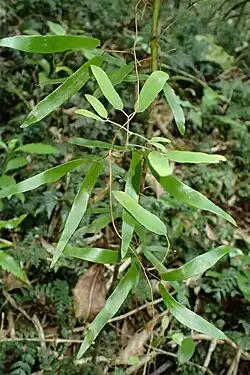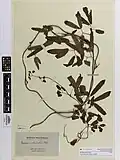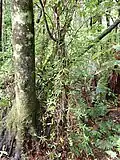Lygodium articulatum
| Lygodium articulatum | |
|---|---|

| |
| Scientific classification | |
| Kingdom: | Plantae |
| Clade: | Tracheophytes |
| Division: | Polypodiophyta |
| Class: | Polypodiopsida |
| Order: | Schizaeales |
| Family: | Lygodiaceae |
| Genus: | Lygodium |
| Species: | L. articulatum
|
| Binomial name | |
| Lygodium articulatum | |
| Synonyms[1] | |
| |
Lygodium articulatum, commonly referred to as mangemange or Bushman's mattress, is a climbing fern endemic to the North Island forests of New Zealand. Mangemange is unique compared to other ferns in the area due to the vine-like curtain it creates in the canopy. The plant is a traditional Māori building material used to fasten structures and construct hīnaki (eel traps), and received its English language name due to early European settlers observing Māori forming makeshift beds in the bush from the plant.
Description
Lygodium articulatum roots extend laterally from the stem (rhizome) of the plant. The rhizomes of mangemange are hairy and long-creeping, giving rise to widely spaced fronds.[2] Fronds grow alternately from the stem and form dichotomous costae that twist and climb until they find nearby branches or trees. Once the plant has the support of a branch, stipes and pinnae form. Mangemange will form either sterile vegetative pinnae (10 cm (3.9 in)) or fertile pinnae (1 cm (0.39 in)). Sterile pinnae are flat and smooth, while fertile pinnae are wrinkled and fan shaped, terminating in spore structures that release a yellow spore-dust when ripe.[3]
Lygodium articulatum will often grow rapidly 3 metres (9.8 ft) high in a tree, where it may become a wall or curtain of leaves and twiggy vines. It is often difficult to navigate through due to the strength of the rhizomes.[4] This behaviour is common to its genus Lygodium, and has led to several members of the genus' widespread success. A common example is the behavior of Lygodium japonicum, which similarly forms dense vertical mats, that are currently highly invasive and damagin in Northern Florida.[5]
Taxonomy
The species was described by Achille Richard in 1832, based on specimens collected by Jules Dumont d'Urville during the 1827 voyage of the Astrolabe to New Zealand.[6] It is the only member of the genus found in New Zealand.[7]
Lygodium articulatum is considered by modern systematists to be a member of a basally divergent clade within the Lygodium genus.[8] While pre-modern phylogenetic studies that relied on morphology had considered it to be a highly derived member of the genus,[9] modern molecular phylogenetic studies have found it to be a member of a basally divergent clade alongside its temperate North American sister, Lygodium palmatum.[10]
In 2013, the taxon Lygodium gracilescens, described by William Colenso in 1896, was synonymised with Lygodium articulatum.[11]
Etymology
The Māori language name mangemange has an uncertain etymology, though it may be related to the Tongan word maamange, a name used to describe yams.[7] Other names in Māori include tarikupenga (snare net) and makamaka.[7] Early European settlers names for the plant included bushman's mattress and bushman's bunk, referring to the use of the plant in bushcraft for makeshift beds.[7] The species epithet articulatum means "joined", and a reference to the stems of the plant.[7]
Ecology
Mangemange is unique compared to other ferns in the area due to the vine–like curtain it creates in the canopy.[4] Although the majority of the plant is found in the canopy of the surrounding forest, the roots and stem of mangemange form on the ground, meaning it cannot be classified as an epiphyte. trampers strung up by plant. British soldiers[7]
Distribution and habitat
Mangemange is mainly found on the North Island of New Zealand, specifically in the Northland, Auckland, Volcanic Plateau, Gisborne and Taranaki regions. It grows from sea level to 950 metres (3,120 ft) in elevation.[3]
Since it is a climbing fern that uses neighboring structures to grow, its habitat is mainly based on the distribution of other species such as the manuka and kanuka scrub, and in kauri, podocarp and broadleaved forest.[3]
Māori cultural uses
In Māori culture, mangemange is a material used to bind constructions, such as whare, and to construct items such as hīnaki (eel traps), due to the durability of the stems. It was also used in traditional burial customs, to fasten bodies to trees before internment.[7] The plant is often a feature of traditional stories, as a material used to trap taniwha.[7]
Mangemange has uses in traditional rongoā medicinal practices, where infusions of fronds are used as a toothache remedy.[7] The leaves when dried could also be used to fasten a diaper, and the plant could be used to form a makeshift bed in the bush. The stems have uses in Māori stone crafting, as they are strong enough to be able to saw through pounamu.[7]
Early European culture
The plant had a poor reputation among British soldiers during the New Zealand Wars, due to the impenetrable nature of the plant's stems.[7]
Gallery
-

-

-
 Young mangemange
Young mangemange -
 Vine-like stems of mangemange in the New Zealand bush
Vine-like stems of mangemange in the New Zealand bush -
 Leaves
Leaves
References
- ^ "Lygodium articulatum A.Rich". Plants of the World Online. Retrieved 28 July 2025.
- ^ Croft, Jim (November 1999). "An Introduction to the Structure of Ferns and their Allies". Australian National Herbarium. Retrieved 7 December 2017.
- ^ a b c "Lygodium articulatum". Flora of New Zealand. Retrieved 7 December 2017.
- ^ a b "Lygodium articulatum". Oratia Native Plant Nursery. Oratia Native Plant Nursery. 2015. Retrieved 7 December 2017.
- ^ "| Center for Aquatic and Invasive Plants | University of Florida, IFAS". plants.ifas.ufl.edu. Retrieved 2023-12-26.
- ^ Richard, M. A. (1832). "Essai d'une flore de la Nouvelle-Zélande". Voyage de la corvette l'Astrolabe exécuté pendant les années 1826–1827–1828–1829 sous le commandement de Jules Dumont d'Urville capitaine de Vaisseau (in French). Paris: J. Tastu. p. 96.
- ^ a b c d e f g h i j k Vennell, Robert (2019). The Meaning of Trees. Auckland: HarperCollins UK. pp. 174–177. ISBN 978-1-77554-130-1. LCCN 2019403535. OCLC 1088638115. OL 28714658M. Wikidata Q118646408.
- ^ Madeira, Paul T.; Pemberton, Robert W.; Center, Ted D. (2008-06-01). "A molecular phylogeny of the genus Lygodium (Schizaeaceae) with special reference to the biological control and host range testing of Lygodium microphyllum". Biological Control. 45 (3): 308–318. doi:10.1016/j.biocontrol.2008.02.004. ISSN 1049-9644.
- ^ Garrison Hanks, Judith (1998). A monographic study of Lygodium Swartz. University of Michigan.
- ^ Madeira, Paul T.; Pemberton, Robert W.; Center, Ted D. (2008-06-01). "A molecular phylogeny of the genus Lygodium (Schizaeaceae) with special reference to the biological control and host range testing of Lygodium microphyllum". Biological Control. 45 (3): 308–318. doi:10.1016/j.biocontrol.2008.02.004. ISSN 1049-9644.
- ^ Brownsey, P. J.; Perrie, L. R. (6 March 2013). "Taxonomic notes on the New Zealand flora: the status of Schizaea australis and S. fistulosa, and lectotypes in Lygodiaceae and Schizaeaceae". New Zealand Journal of Botany. 51 (2): 79–87. doi:10.1080/0028825X.2012.741066. ISSN 0028-825X. Wikidata Q135485154.